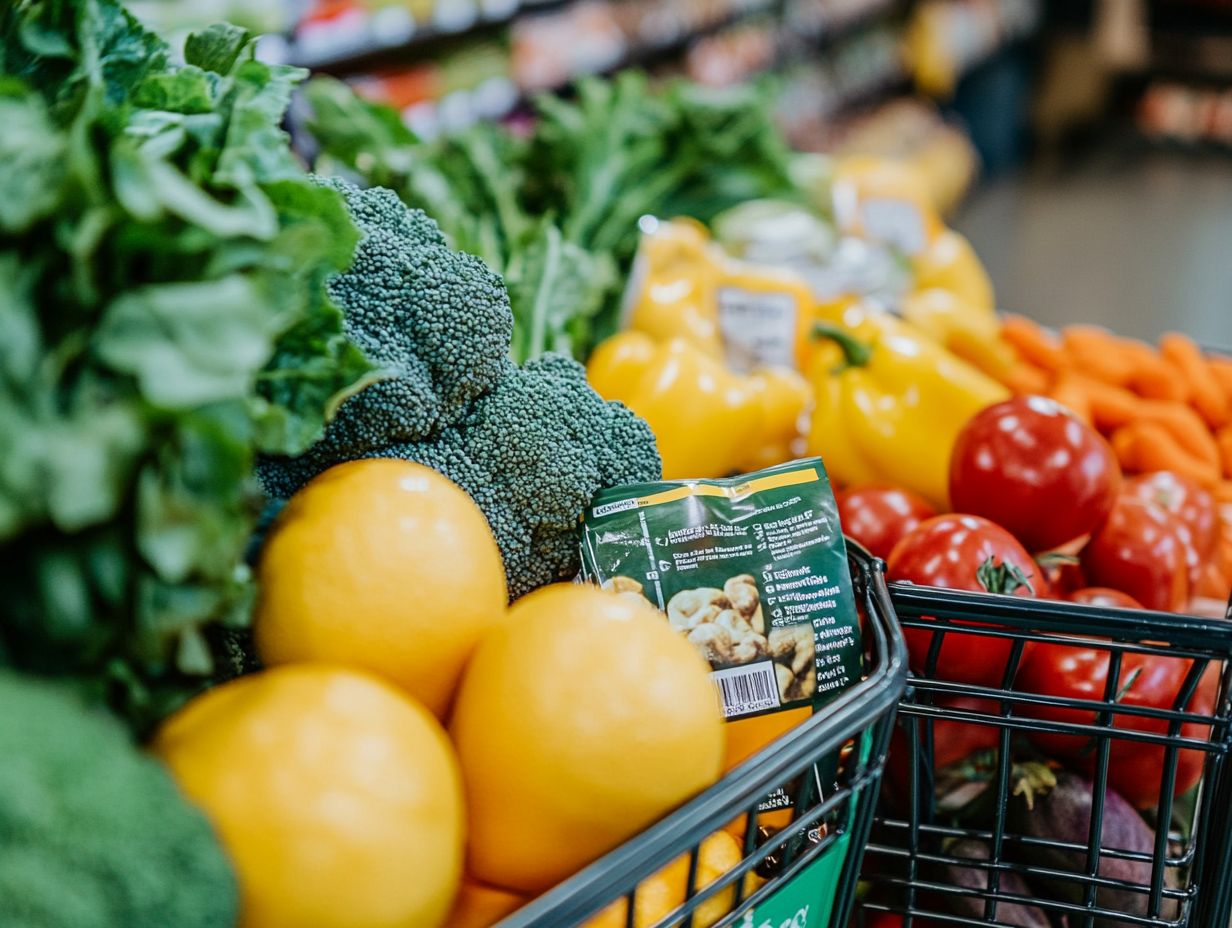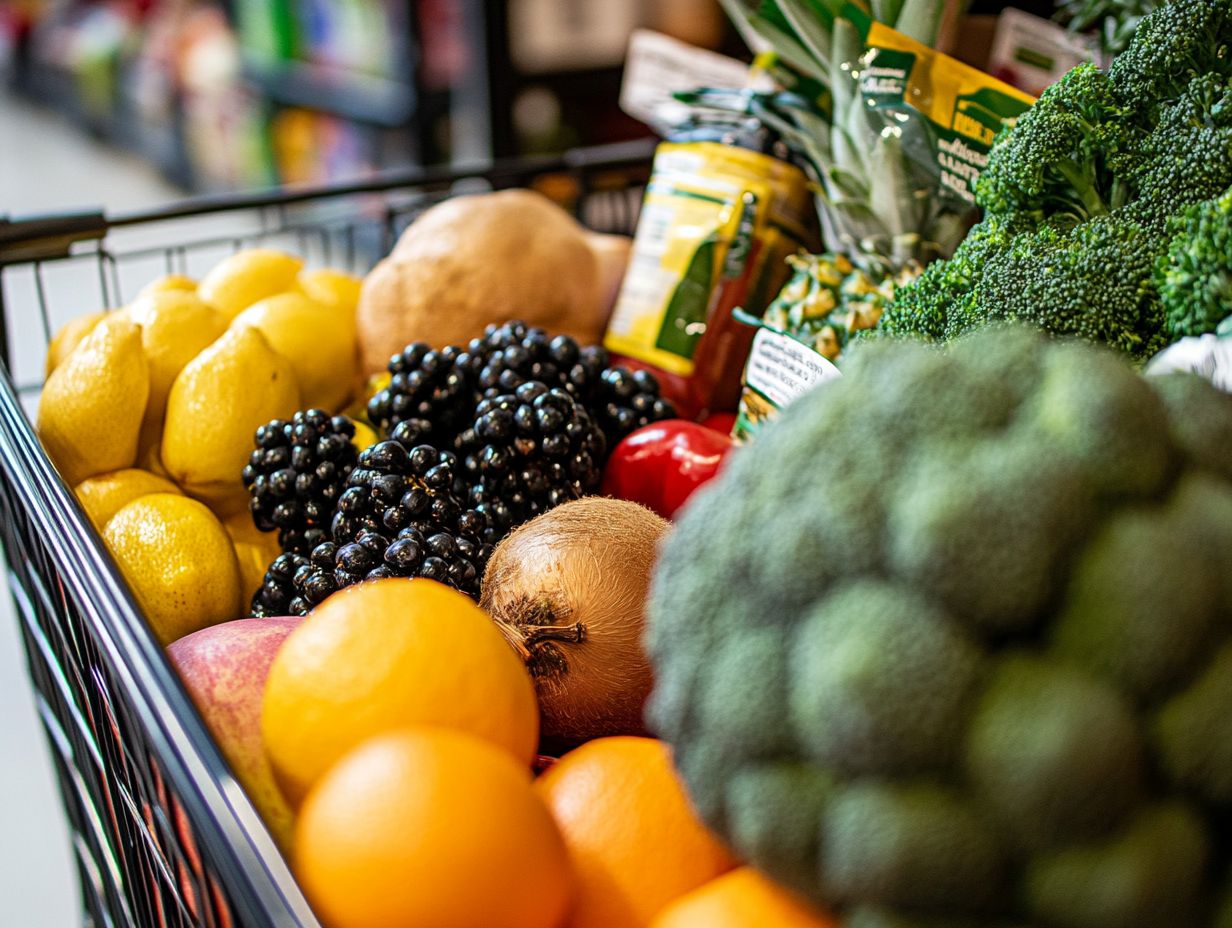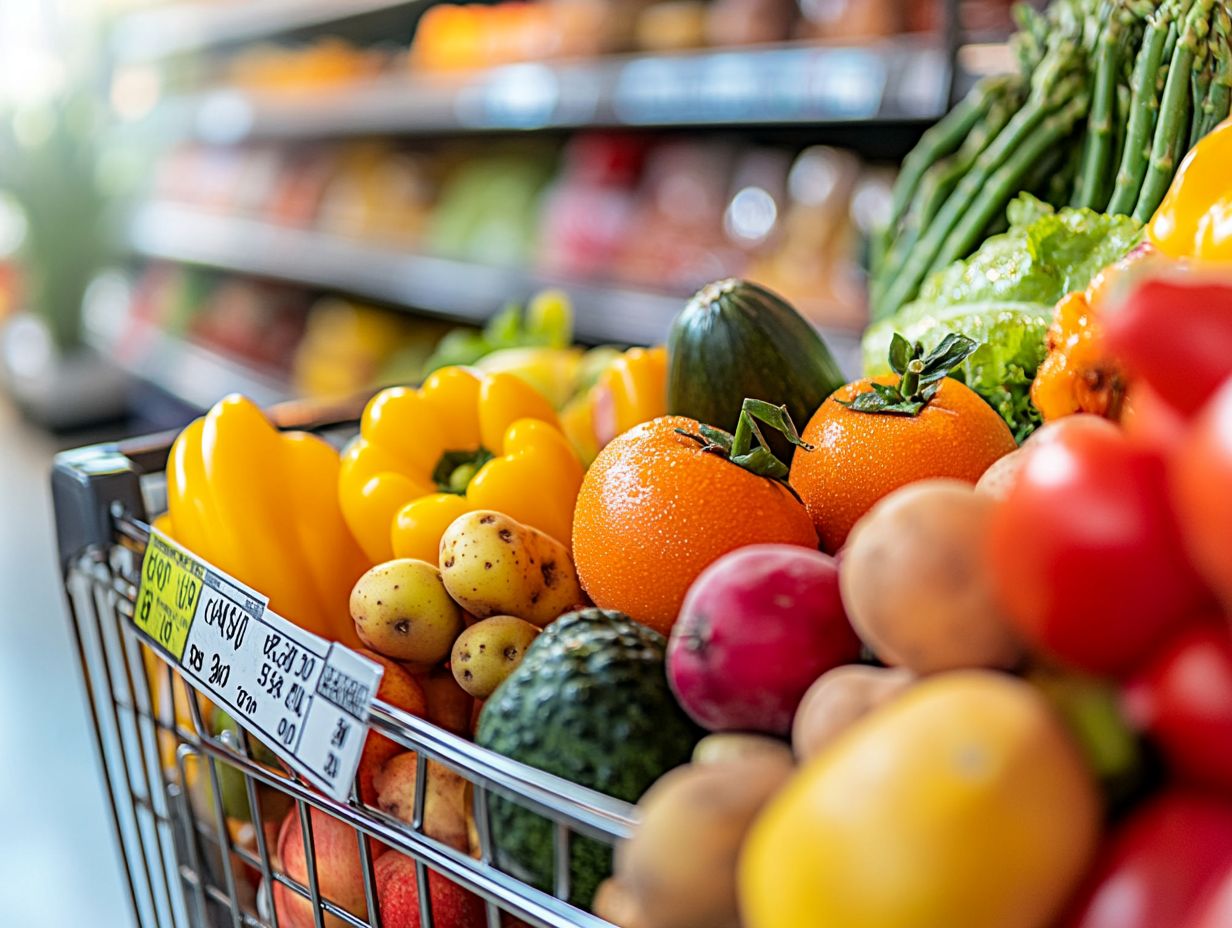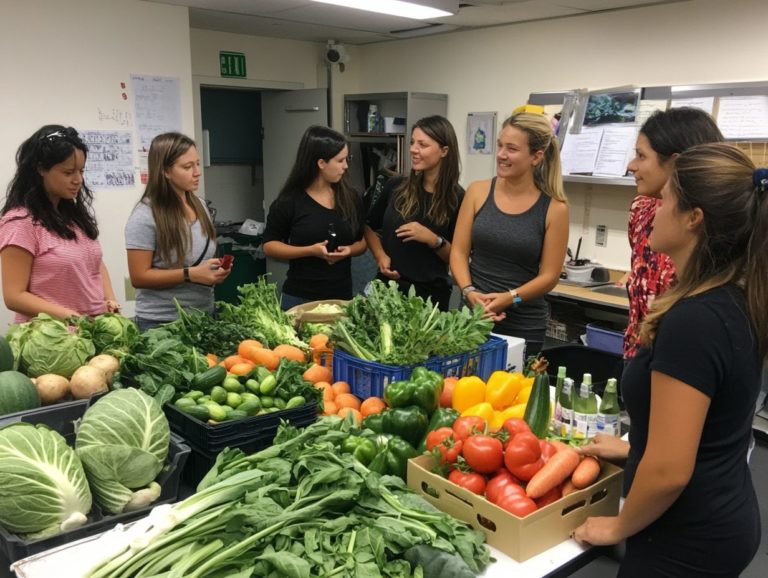What Do You Need to Know About Nutrition Labels?
Nutrition labels play a pivotal role in guiding your food choices. They provide insights into serving sizes, nutrient content, and ingredient lists. Yet, the sheer volume of information can feel overwhelming.
This article distills the essential components of nutrition labels, equipping you with the knowledge to decipher their intricacies and identify hidden ingredients. By mastering these elements, you ll confidently navigate the grocery aisles and make healthier eating choices.
Take charge of your food decisions!
Contents
- Key Takeaways:
- Understanding Nutrition Labels
- Interpreting Serving Sizes
- Decoding Nutrient Information
- Reading Ingredient Lists
- Using Nutrition Labels for Healthy Eating
- Limitations of Nutrition Labels
- Frequently Asked Questions
- What Do You Need to Know About Nutrition Labels?
- What information is included in a nutrition label?
- Why is it important to read nutrition labels?
- How do I know if a food is healthy based on its nutrition label?
- Are there any sneaky tricks to look out for on nutrition labels?
- Can nutrition labels help me manage specific dietary restrictions?
- Do all foods have nutrition labels?
Key Takeaways:

- Nutrition labels provide key information on the nutrients and ingredients in packaged foods, helping consumers make informed food choices.
- Serving sizes on nutrition labels can be misleading, so it’s important to pay attention to portion sizes and use measuring tools when necessary.
- Important nutrients, such as vitamins and minerals, can be found on nutrition labels and should be included in a balanced and healthy diet.
Understanding Nutrition Labels
Understanding nutrition labels is vital for making informed food choices while grocery shopping. These labels offer essential insights into the nutritional value of food products, guiding you through the often confusing landscape of food marketing and processed options.
Regulated by the FDA (Food and Drug Administration), nutrition labels include key elements like serving size, total calories, and essential nutrients. By familiarizing yourself with these details, you can elevate your healthy eating habits and enhance your overall health and wellness.
Key Information Included
Nutrition labels are your go-to resource for understanding exactly what you’re consuming. They offer vital details like:
- Calories
- Total fat content
- Saturated fat
- Trans fat
- Cholesterol
- Sodium
- Carbohydrates
- Dietary fiber
- Added sugars
- Protein
- Essential vitamins
Focusing on these elements is crucial for making informed dietary choices and maintaining a well-rounded diet. Knowing the amount of dietary fiber in your food helps you select options that promote digestive health and create a sense of fullness, which is beneficial for weight management.
Your protein intake is equally important. It plays a key role in muscle repair and growth while keeping your energy levels stable throughout the day. Monitoring added sugars and sodium can help you sidestep chronic health issues, underscoring the importance of being mindful about what you consume.
By exploring these components, you can truly appreciate how each meal contributes to your overall well-being.
Interpreting Serving Sizes
Interpreting serving sizes is essential for effectively understanding nutrition labels. The serving size determines the amount of each nutrient listed, allowing you to assess how your food choices align with your daily dietary goals.
For example, the daily value percentages reveal how much a serving contributes to the overall recommended intake of specific nutrients. This information can significantly influence your health outcomes, especially if you’re managing conditions like diabetes or heart health.
How to Determine Portion Sizes
Determining portion sizes can be quite the puzzle, but mastering this skill is essential for maintaining a healthy diet and making informed food choices. The serving size on nutrition labels serves as your compass, guiding you through the nutritional landscape of a product.
Utilizing measuring cups and spoons can be incredibly helpful in grasping what a proper portion looks like, allowing you to serve food more accurately. Visual cues can also be a game changer; for instance, think of using your fist for a serving of vegetables or your palm for protein to estimate appropriate amounts without fancy tools.
Adjusting portion sizes based on your personal dietary needs, such as your activity level, weight goals, or specific health conditions, is vital. Keeping a food diary can be a useful way to track these adjustments. Educating yourself about serving sizes and portion control is key to cultivating mindful eating habits, enabling you to make healthier choices that align seamlessly with your lifestyle.
Decoding Nutrient Information

Decoding nutrient information on nutrition labels is crucial for identifying the essential nutrients that promote your overall health and wellness. Understanding health claims and nutrient claims on food packaging is equally important.
As processed foods become more prevalent, honing your ability to analyze this information is essential for making informed dietary choices and managing your nutritional intake effectively.
Identifying Essential Nutrients
Identifying essential nutrients is a vital part of reading nutrition labels. Components like dietary fiber, total fat, protein, and vitamins are key to maintaining your health and preventing food allergies.
Understanding the benefits of these nutrients enables you to make healthy choices in your diet. For example, dietary fiber is crucial for digestive health and helps regulate blood sugar levels. The recommended daily intake is typically around 25-30 grams.
Balanced fat intake, especially healthy fats found in avocados and nuts, supports heart health and aids in nutrient absorption. Protein is fundamental for muscle repair and growth, with a suggested intake of about 46-56 grams for adults.
Focus on whole foods rich in these nutrients think fruits, vegetables, lean meats, and whole grains. You can effortlessly construct meals that promote your overall wellness.
Reading Ingredient Lists
Reading ingredient lists is essential for grasping what s genuinely in the food you consume. Many processed foods can harbor hidden ingredients, making this practice particularly crucial for anyone with food allergies or specific dietary restrictions.
Ingredient lists meticulously outline every component in a food product, enabling you to make informed choices regarding your diet and overall health. By taking a moment to scrutinize these details, you ensure that your food choices align with your wellness goals.
Identifying Hidden Ingredients
Identifying hidden ingredients on food packaging is essential for anyone striving to maintain a healthy diet. Many processed foods harbor additives and preservatives that aren t immediately obvious.
Common hidden ingredients include artificial flavors, high-fructose corn syrup, and trans fats. These can contribute to a range of health concerns, from obesity to heart disease. Cultivating the habit of reading labels with care and prioritizing whole foods over overly processed options is vital.
When you re shopping, aim for products with shorter ingredient lists. Focus on items with recognizable and natural ingredients. Making simple swaps, like choosing whole grains instead of refined ones, can lead to a healthier you!
Using Nutrition Labels for Healthy Eating
Utilizing nutrition labels effectively can greatly elevate your healthy eating habits. By analyzing the nutrition facts of various products while grocery shopping, you enable yourself to make informed food choices.
This practice deepens your understanding of nutritional content and allows you to align your selections with dietary guidelines and your personal health objectives, whether that s weight loss, heart health, or overall wellness.
Making Informed Food Choices

Making informed food choices is essential for achieving a balanced diet and maintaining overall health. Understanding nutritional value is key. It helps you see how food fits into your daily diet.
To evaluate your food options effectively, start by scrutinizing nutrition labels. You’ll find key information about calories, sugars, and essential nutrients. By assessing nutritional value, you can prioritize foods that provide the most vitamins and minerals for the least amount of calories.
Understanding portion sizes is equally important. It helps you manage your intake without feeling overwhelmed, making it easier to stick to your dietary goals.
Consumer education is vital in this journey. It enables you to navigate food labels with confidence, ensuring that your choices align perfectly with your health objectives and lifestyle.
Limitations of Nutrition Labels
Nutrition labels are useful. However, they have limitations that can lead to misunderstandings about food content. Often, they leave out valuable information needed to make informed, healthy choices.
These limitations can arise from marketing strategies that highlight certain nutrients while downplaying others. You should be mindful of these pitfalls as you make dietary decisions.
What Information is Missing?
The information often absent from nutrition labels can include crucial details about nutrient bioavailability, ingredient quality, and the impact of food processing on nutritional value.
These omissions can profoundly impact your choices. They may lead you to select products that don t align with your health goals or nutritional needs. Without a solid grasp of how these factors intertwine, you might unwittingly choose less nutritious options, potentially compromising your wellness.
This highlights the essential need for enhanced consumer education. Equipping yourself with comprehensive knowledge enables you to make informed decisions.
By understanding the importance of ingredient quality, you open the door to healthier choices! By recognizing processing methods, you can navigate the complexities of food labels more effectively. This, in turn, paves the way for improved health outcomes and fosters a more conscious approach to your nutrition.
Frequently Asked Questions
What Do You Need to Know About Nutrition Labels?
Nutrition labels are important for understanding the nutritional value of the foods we consume. Here are some commonly asked questions about nutrition labels:
What information is included in a nutrition label?

A nutrition label typically includes information on serving size, calories, macronutrients (such as fat, carbohydrates, and protein), micronutrients (such as vitamins and minerals), and sometimes other important nutrients like fiber and sodium.
Why is it important to read nutrition labels?
Reading nutrition labels helps you make informed decisions about food choices. It allows you to see the nutrient content of a food and whether it aligns with your dietary needs and goals.
How do I know if a food is healthy based on its nutrition label?
A general rule of thumb is to look for foods that are lower in calories, saturated fat, sodium, and added sugars. Additionally, aim for foods that are higher in fiber, protein, and essential vitamins and minerals.
Are there any sneaky tricks to look out for on nutrition labels?
Yes, some foods may appear healthy based on their packaging or marketing. However, a closer look at the nutrition label may reveal high amounts of added sugars or unhealthy fats. For example, many flavored yogurts contain added sugars. It’s important to always check the ingredients list and nutrition label for an accurate understanding of a food’s nutritional value.
Can nutrition labels help me manage specific dietary restrictions?
Absolutely! Nutrition labels can help you identify foods that may contain allergens or trigger certain health conditions. For example, individuals with celiac disease can check for gluten-free labels, and those with high blood pressure can keep an eye on sodium levels.
Start reading nutrition labels today to make better food choices!
Do all foods have nutrition labels?
No, not all foods have nutrition labels. Most packaged foods in the U.S. must have nutrition labels.
Fresh foods like fruits, vegetables, and meats typically don t come with these labels. Do you know what s really in your food?






